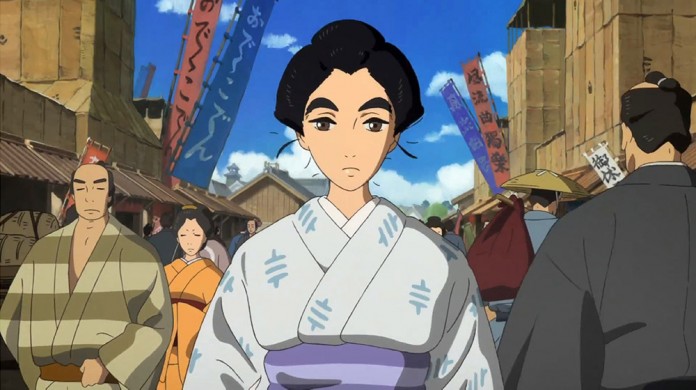This animated semi-biographical gem from renowned director Keiichi Hara (Colorful, Summer Days With Coo) tells the stirring story of O-Ei, daughter of, and assistant to the legendary Japanese artist Kasushika Hokusia; painter of the woodblock print masterpieces Thirty-Six Views of Mouth Fuji and The Wave off Kanagawa.
Set in 1814 Edo (Tokyo), Miss Hokusai is an elegant tale of family relationships and friendship at a time of emotional conflict and unrest. While deftly deploying a unique swathe of superb comedy and drama, the story sifts into the realm of flattering fantasy but isn’t overburdened by the kind of surrealist set pieces that adorn other Japanese fantasy features.
Based on Sarusuberi, a manga by Hinako Sugiura, the story follows O-Ei and how she helped paint many of her father’s sterling works. O-Ei cares for her younger blind sister O-Nao while fending off potential local suitors. It was also rumoured she painted some of Kasushika’s works entirely by herself. Even though the art was personally signed by Kasushika, his name was simply scrawled on the pieces to provide a greater financial incentive for potential buyers.
O-Ei is focused, caring and loyal to her family while her father Kasushika, referred to by his real name “Tetsuzo” throughout (Kasushika Hokusia was one of his many pseudonyms), is grouchy, abortive, disillusioned yet often reflective and, despite the allegations of forgery, refused to live an opulent, materialistic life. Tetsuzo erupts into wild tantrums, discards his family wishes in favour of art and fraternises with oafish students who spend most of their time drinking with geishas.
Tetsuzo’s students are burly, competitive and insolent but their bumbling idiosyncrasies are amusing in a film that is otherwise so rousing and magical. The myriad of emotions Miss Hokusai efficiently summons are it’s key strength, as the story niftily flits through genres like historical epic, family drama, slapstick comedy and supernatural fantasy, without ever feeling ill-toned or unfocused.
Paradoxically, Miss Hokusai is at its most magical during its most naturalistic moments, through heart-felt family drama and via its supple artistic design, which doesn’t overwhelm or submerge the story in outlandish, otherworldly attributes. Scenes featuring O-Ei and her younger sister O-Nao are totally beautiful. Observing O-Nao react to the clattering of a street market as it trundles past her across a bridge, conveys a natural wonder, along with the moment she smiles at the sound of snow crashing to the ground from shimmering tree tops. After a young boy realises O-Nao is blind, longing for aural stimulation, he shakes the trunk to make the snow fall for her.
The fact that millions of dollars are all too frequently siphoned into aneurism-inducing blockbusters that do nothing but deaden the eyes, numb the brain and pound the soul, seems all the more confounding at the sight of Miss Hokusai describing the colour of a rose to her blind, younger sister: a stunning scene with the emotional heft to rouse a tsunami of heartache, pulp a squadron of Transformers into stickle-brick particles and plant a petal in the palm of Michael Bay. Then watch him sneer and laugh maniacally as he crushes it with his giant mechanical fist.
The wide variety of characters and colourful emotions evoked make Miss Hokusai visually modest yet totally captivating and perfect for the big screen where one can fully immerse in its sublime drama and humble animation. Even a doe-eyed head tilt by the family dog successfully puckers the heart strings while heavy rock instrumentals played over bucolic backdrops will raise smiles, along with the supernaturally tinged fantasy/ dream sequences.
Miss Hokusai can sometimes feel a little too light on its feet, with a tendency to meander from the narrative path, but its dipping in and out of various lives and dramas, makes it all the more vibrant and unique. It’s a fanfare for classical 2D animation that prioritises story and character over gaudy visual design and empty, convoluted action. Keiichi Hara’s latest will surely stir all who experience it and will appeal to Japanese anime fans but especially to those who are more partial to The Tale of Princess Kaguya than Fist of the North Star.








